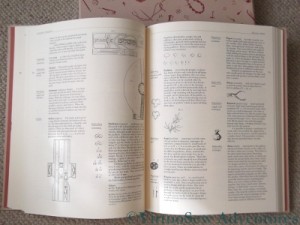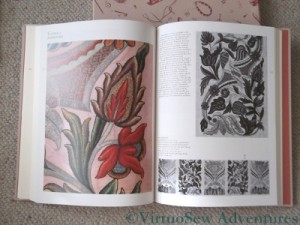An addition to my library
Charles Germain de St Aubin was designer to Louis XV of France, and he wrote a famous work entitled “The Art of the Embroiderer”, which is much referenced among scholars of textiles of the period, but has proven tricky to track down. Not to mention, my grasp of seventeenth century technical French really isn’t up to scratch.
Now, however, I’ve got hold of a recent translation. The Los Angeles County Museum of Art commissioned a translation, and produced the resulting book splendidly, with colour plates of interesting relevant textiles from their collection (annotated by the curator) and a facsimile of the original work, all on good paper and properly bound and presented in a slipcase. I gloat quietly to myself every time I look at it!
The book is of interest to me because he talks of chenille embroidery, and implies that there are two known methods for making a chenille yarn, one of markedly poorer quality than the other. This is very strange, because until some time in the seventies you would have been told that there was only one way to make a chenille, and that the method St Aubin dismisses as being of poor quality. As far as I am aware no one has yet worked out quite what St Aubin meant, or what other technique he was referring to.
Wouldn’t it be wonderful to find out!



how interesting. i have made some chenille many years ago when they came out with that amazing chenille tool. i also have lots of squares of vintage chenille that i got on ebay and have used to make a couple of blankets for children. there are so many beautiful patterns. the book sounds wonderful.
Germain….and in a slipcase!
I’m drooling so much, it’s bubbling! (I apologise for the mental picture!)
The zoom is unclear – rats!
I love puzzles and that book has me turning green with envy.
It looks like a wonderful book – the colour plate looks fabulous! The only chenille I know how to make is ‘ faux chenille’ – stitching several layers of fabric together on the diagonal with evenly spaced parallel lines, then cutting through all the layers except the back one between the lines of stitching. Once washed and tumbledried, you end up with a lovely thick fabric.
This looks like a wonderful book! I know you’ll have many, many pleasurable hours checking out each and every stitch.
I love to get new books and don’t blame you art all for gloating….gloat away!
Wonderful colour plate!
What a marvellous find, and how interesting. Enjoy your researching!
I have the exact same copy! I bought it many years ago at a needlework seminar. At the time, I wondered why I was buying it since I did only counted thread embroidery. Later, when I moved on to surface embroidery, I was very glad I did!
Also, when the Plimoth jacket project began, and I first used a slate frame, I was tickled to see the detailed directions of slate frames on pp 23-25.
I’m sure you’ll enjoy it for many years to come, too!
Another interesting project for you then! Good luck with that one! 🙂
I was a weaver for many years, and as I recall, these days chenille is made from cotton or rayon. Although much more slippery, rayon holds up better than the chenille made from cotton. I’ve woven with rayon chenille and love the shine and feel of the finished product, but it still tends to worm itself out of the braided fringe.
Love the book!
I think we should put Tricia Wilson Nguyen on the hunt for the answer to the chenille thread. I had the good fortune of acquiring a small bit of vintage silk chenille. It FAR surpasses any versions silk or otherwise of chenille thread made today in both stitchability (it doesn’t worm) and it’s sheen and beauty. I have a number of antique chenille pieces and I believe they were stitched with this finer version of chenille. I too would join you in wanting to know the answer….
I just bought the book. Thanks for telling me about it!